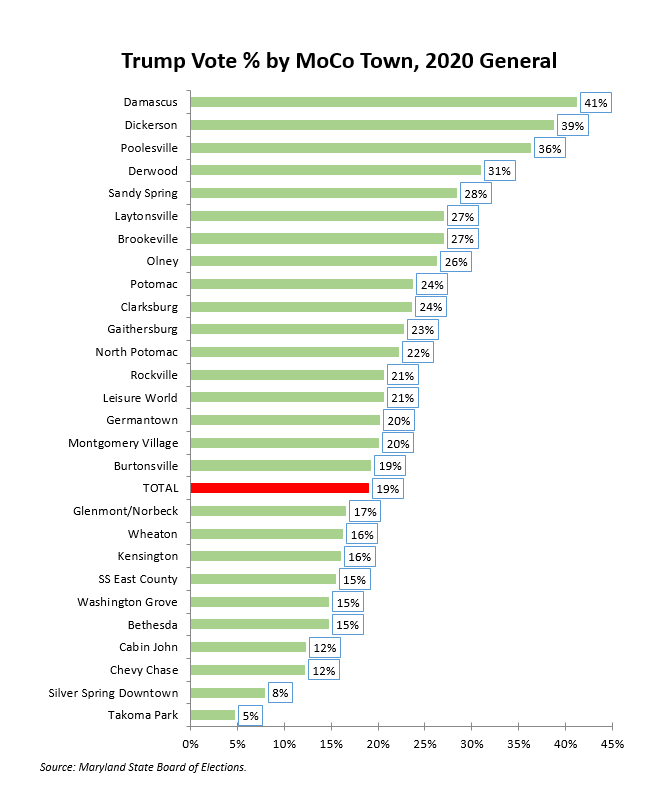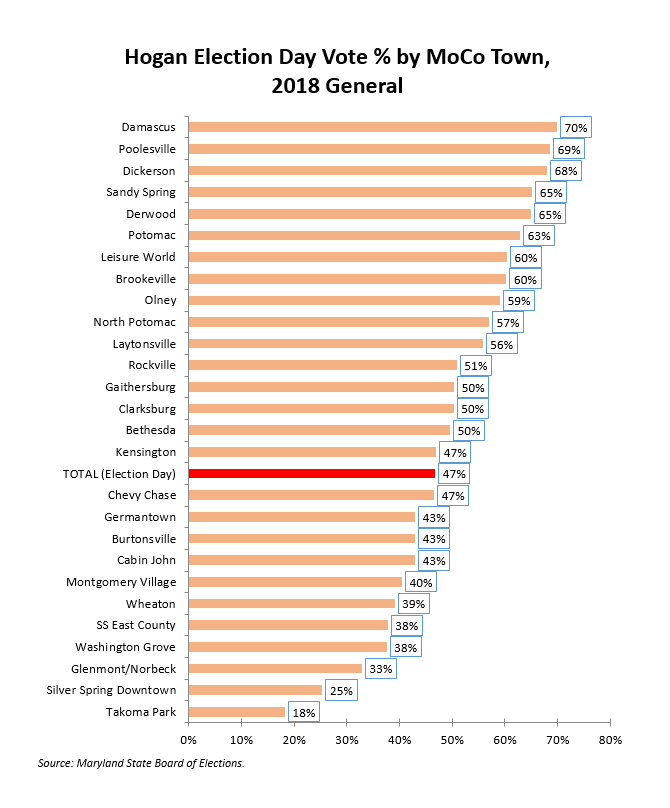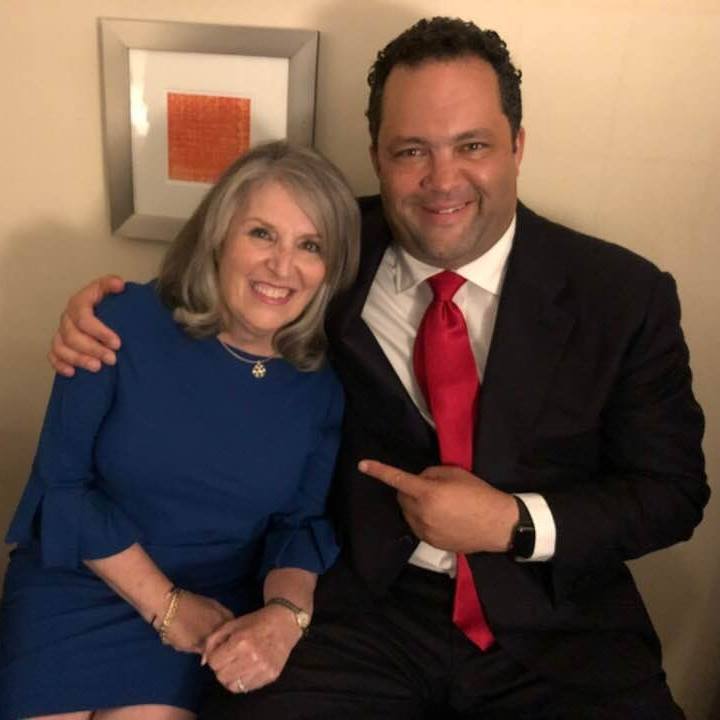It was a strange night in Maryland. Republican Gov. Larry Hogan didn’t just win reelection. He crushed it, defeating Democrat Ben Jealous by 56.2% to 42.7%. This handsome 13.5% margin is stunning for a Republican in a state that went for Hillary Clinton by 26%.
But Hogan’s rout was a personal, not a partisan, victory. The Governor had no coattails. Heck, he had anti-coattails as Democrats did very well below the top. Democratic AG Frosh and Comptroller Franchot won reelection by enormous margins.
Results Tracker at https://tinyurl.com/ybtwqv4m has the latest for all the key races in the Senate, House of Delegates, and County Exec races. Check it out.
Senate
In the state Senate, Hogan’s “drive for five” seats needed to sustain his veto melted into “we’ll settle for one.”
Democrats narrowly lost two seats. Baltimore County District 42 was expected to fall to Republican Del. Chris West and did, though by a surprisingly small margin. Democratic Sen. Jim Mathias was always defying gravity on the Eastern Shore and finally fell to Republican Del. Mary Beth Carozza.
But Democratic Sen. Kathy Klausmeier held on to beat back a challenge from Republican Del. Christian Miele in Baltimore County District 8. Democrat Sarah Elfreth held open Anne Arundel District 30 by a solid margin. In Frederick, Democratic Sen. Ron Young was thought to be in deep trouble but won reelection by his largest margin by far.
Democrats scored an upset in Howard/Carroll District 9 where Republican Sen. Gail Bates appears to have narrowly lost to Democrat Katie Fry Hester, as Howard’s highly educated electorate turned hard against the Republicans.
We’ll have to wait on absentees and provisionals but the absentees are unlikely to save Bates. While Democrats compose 39% of active registered voters, they comprise 51% of received absentees.
The new Senate will have 32 Democrats and 15 Republicans.
House of Delegates
Last night was about making gains rather than staunching losses for Democrats. Not a single vulnerable Democrat lost. Instead, Democrats are poised to add five seven more seats to their already hefty majority.
In Howard District 9B, incumbent Republican Robert Flanagan lost by 14 points to Democrat Courtney Watson, who returns to office after losing the 2014 county executive race. In Anne Arundel District 30A (Annapolis), Del. Herb McMillan’s retirement allowed Democrat Alice Cain to take the second seat and join seatmate Speaker Michael Busch in the House.
Baltimore County District 8 will now send two instead of one Democrat to the House. Democrat Eric Bromwell won reelection and will be joined by Harry Bhandari. Republican Del. Joe Cluster lost his seat as Del. Joseph Boteler is the sole Republican.
St. Mary’s County District 29B delivered a real surprise as incumbent Republican Del. Deb Rey lost to Democrat Brian Crosby, an army ranger who ran as a moderate or conservative Democrat.
In Harford District 34A (Havre de Grace), it looks like incumbent Democratic Del. Mary Ann Lisanti will be joined by Steve Johnson, who currently leads incumbent Republican Del. Glen Glass by a whopping 25 votes.
This one will go to absentees and provisionals. Among the received 583 absentee ballots, 271 (46%) were sent back by Democrats, 196 (34%) by Republicans and 116 (20%) by unaffiliated or minor party registrants. Among active registered voters, 49% are Democrats compared to 28% who are Republicans.
Unlike in Senate District 9, the party affiliation of received ballots doesn’t send enough of a signal to suggest a clear winner, so we really will have to wait for the final count on this one.
Two more surprise pickups: In Baltimore County District 42A, Democrat Michelle Guyton looks set to take the second of two delegate seats. She leads Tim Robinson by 306 votes. Meanwhile, in single-member Frederick County District 3B, Democrat Ken Kerr leads incumbent Republican Del. Bill Folden by 552 votes.
Assuming the Democratic pickups in 3B, 34A, 42A holds up, the new House of Delegates will have 97 99 Democrats and 44 42 Republicans.
County Races
Democrats had a really good night at the county level. In two upsets, Steuart Pittman took out incumbent County Exec. Steve Schuh in Anne Arundel, and former Councilmember Calvin Ball defeated incumbent Allen Kittleman in Howard. Ball becomes Howard’s first African-American county executive. Democrats also captured a majority on the Anne Arundel Council.
Democratic County Executive Jan Gardner won reelection over Republican Del. Kathy Afzali in Frederick. In Baltimore County, former Del. Johnny Olszewski defeated Al Redmer by 15 points in what had been billed as a nailbiter.
In Montgomery, Councilmember Marc Elrich easily dispatched not just Republican Robin Ficker but wayward Democratic Councilmember Nancy Floreen, who ran as an independent. State’s Attorney Angela Alsobrooks won the county executive race in Prince George’s without opposition. She becomes the first African-American woman county executive in Maryland.
In Dorchester County, Democrats won one more seat on the county council, giving them a majority (as in Anne Arundel noted above). Democrats also won an additional council seat apiece in Talbot and Worcester, as well as two more in Wicomico. That gives Dems a net gain of 6 county legislative seats and a total of 52. Republicans are down to 73 from 79.
Democrats retained control of all of the seats in Charles, Montgomery and Prince George’s, and held their majorities in Baltimore and Howard Counties.
Republicans can take minor solace that they retained their one seat majority in Frederick and continue to hold all the seats in Carroll and Harford Counties. They also continue to rule in the vast majority of Maryland’s many more rural counties on the Eastern Shore, Western Maryland, as well as in Calvert and St, Mary’s.





